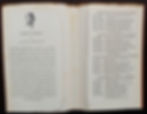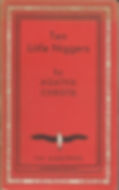INSIGHTS: The Rare Albatross Paperbacks
- David Morris
- Apr 25, 2021
- 7 min read
Updated: Jan 17, 2022

Collectors of Agatha Christie’s works need to be familiar with the publisher Albatross. All of their pre-World War II Christie paperbacks are true first paperbacks for those Christie titles. Surprisingly, awareness of this imprint is low and many online sites still incorrectly list much later printings by Pocket Books, Collins or Penguin as the first paperbacks.
During a seven-year period (1933-1939), Albatross published 14 Agatha Christie books under their own Crime Club imprint. The first was Lord Edgware Dies (Volume 115, 1933). From this volume through to Appointment with Death (Volume 444, 1938), Albatross printed every Agatha Christie released during these years except The Listerdale Mystery. Many of these books were published within a few months of their first Collins UK hardback printing, but all are true first paperbacks.
After World War II, Albatross printed two further Christie titles: Ten Little Niggers and One, Two, Buckle My Shoe. These were the last two Christie printings and neither was contemporaneous with the first hardback nor were even the first paperbacks.
A History of Albatross:
The Albatross Modern Continental Library was launched in 1932 to sell books printed in English to those on the European continent. Part of the appeal for the word Albatros(s) is it's the same in German, French and Italian, allowing for seamless multi-national branding and marketing. The ten initial books selected for publication included Aldous Huxley’s Brave New World and James Joyce’s Ulysses. Within a few years the catalogue grew to include D.H. Lawrence, Evelyn Waugh, Agatha Christie, A.A. Milne, and Dorothy L. Sayers.

Albatross was in direct competition to Tauchnitz who also published in the English language in continental Europe. Albatross found an ability to gain a foothold through the use of high-quality yet affordable paperback books, combined with design improvements and more proactive marketing. In addition, Albatross made a prescient move into publishing crime fiction for what would become the genre's golden age. Tauchnitz had broadly failed to see this consumer trend prior to 1932, with few well known crime authors in their catalogue, aside from Conan Doyle. Within a few years Albatross had gained enough size with its robust and appealing catalogue to become a viable publisher in Europe in the English language space.
Under the grand sounding Albatross Modern Continental Library, they published approximately 400 volumes between 1932 and 1939. Albatross further segregated the catalogue into genres, each with its own colour scheme. One such scheme was The Albatross Crime Club, launched in 1933, which utilized a red and black colour scheme. Later in 1937, they also launched the Albatross Mystery Club; this scheme had a green and grey colour for the covers. Many more titles were published under the Crime Club banner than the Mystery Club. Between them both, there were approximately 100 titles published.
Albatross ending its pre-war printing in 1939. After the war, Albatross tried ineffectively to restart publishing books. As mentioned earlier, only two Agatha Christie books were published in Italy post-war.
The Collins Influence:
The Albatross Crime Club was closely linked to the Collins’ The Crime Club in the UK. Publishers William and Ian Collins started their Crime Club in 1930 and when Albatross started their's, both joined its Board of Directors. In many ways the Albatross Crime Club was the de facto continental imprint of the Collins Crime Club, certainly pre-war. Collins restricted Albatross from selling their books in the British Empire or USA to avoid competition as these markets were still selling the higher priced hardbacks during this period.

Collins even helped with the printing of the books, with the titles published up to 1937 being printed in Scotland and then being sent to Europe for sale. Only the later titles were actually printed on the continent, in Germany. In addition, Collins provided the gunman logo for Albatross to use, providing a visual connection between the books.
Albatross Design & Innovation:
These original Albatross books introduced a number of elements that were later widely copied throughout the industry. It should also be stated they are lovely books to hold and own. They have a really solid feel and sense of quality to them. The designer was Hans Mardersteig, at that time Art Director of the Italian printers Mondadori, whose proprietor, Arnoldo Mondadori was the Chairman of Albatross's Board. He chose a book size of 18 x 11 cm, in line with the ‘golden ratio’ of 1.618 widely used in art and architecture. Albatross also expanded the idea of colour-coding the books to communicate the core theme, a concept briefly used by Tauchnitz. As a further innovation, although one that did not endure so long with global competitors, Albatross introduced dust wrappers for their paperbacks, initially in a transparent material, and from late 1933 in paper, repeating the cover design.


During World War II paper shortages put an end to that practice with those still printing books. When Albatross restarted in 1947, they did continue issuing books with jackets.
Paperback Competitors:
Albatross’s success inspired the launch of Penguin books in 1935 after Allen Lane had failed to form a joint venture with them. Lane’s approach was one that would likely fail today in a copyright infringement suit as it seems to have been ‘if in doubt, emulate’. Penguin books adopted the same size for the books (in fact most others did too making this the ongoing standard for paperbacks), the use of dust jackets, and a simple solid colour-coded approach to genre. It should also be noted that Allen Lane’s choice of a sea bird for the name and logo of his paperbacks (penguin) can hardly be a coincidence. While Penguin was able to secure the rights to a Christie title for their inaugural launch of 10 titles, it was Christie’s first book, then 14 years old.

Collins also assumed some similar design elements, though their working relationship with Albatross was clearly more amicable. The launch the White Circle series of paperbacks in the UK was a year after Penguin, in 1936. Collin’s first volume in that series was Murder on the Orient Express, which had already been published by Albatross two years earlier.
Printing History:
From book #1, James Joyce’s Dubliners, in 1932, Albatross numbered each book though not always in a sequence one would expect. Books #1 through #187 were all printed in Scotland by Collins for Albatross, and then shipped to Europe. In late 1937, Albatross started changing their approach. It appears they may have temporarily changed printers in Scotland and they also redesigned their numbering system. These earlier books had prices on the rear jacket panel, but not the book. Consistent with the cities cited on the front panel – Hamburg, Paris, Bologna – the prices were ‘Reichsmark 2.00, Francs 12,50, Lire 10’.

From that point on, Albatross jumped to #400 for any Crime or Mystery Club titles. Similar to Collins who in this period used the Collins Mystery imprint for books who weren’t clearly crime novels (i.e. The Listerdale Mystery and Parker Pyne Investigates), Albatross also segregate books under these two approaches. The Mystery Club club began in 1937 and numbers #401-409 are all under this imprint. From book #410 (May 1938) onwards all Crime Club titles are now printed in Germany. Pre-war publishing ended in 1939.
The Post War Albatross Christies:
For a completist, there are two additional Christie’s published by Albatross you will need to locate, though neither are first paperbacks. When Albatross attempted a revival after the Second World War, it still had some support from Collins, but it was much less successful and there was to be no re-launch for the Albatross Crime Club. In 1947 printing appears to have moved to Verona, Italy while Albatross based their operations out of Rome. Crime genre books were now numbered in the 500 range. It should be noted that Albatross used different numbering sequences for different genres, so it is very hard to infer printing dates or numbers of total books solely off the numbering system.

A total of four crime titles were published in this post-war main series (Albatross logo, not gunman). Half were Christie books: Ten Little Niggers (book #554, 1947) and One, Two, Buckle my Shoe (volume 575,1950). While #554 was a paperback first printing, #575 was printed in a cream coloured stiff card binding but with a customary dust jacket design. Frequently this last Christie appears to have been sold in the Scandinavian countries and may reflect that on the title page.
Also of note, it is slightly odd in that versions of #554 showing the 1947 date (in Roman numerals) on the title page, do list One, Two, Buckle My Shoe on the prior pages list of other Christie titles published by Albatross so it is possible #554 was reprinted in 1950. We know of no other potential reprint scenarios so we will rely on readers to fill in the gaps here and elsewhere in this article. For both, Pocket Books had already beaten Albatross to the first paperback printing of these titles.
The Albatross Crime Club Christie Titles:
115: Lord Edgware Dies, 10/1933
121: Murder on the Orient Express, 1934
133: Why Didn’t They Ask Evans, c. 1935
138: Parker Pyne Investigates, 1935
140: Three Act Tragedy, 1935
147: Death in the Clouds, 1936
156: The Hounds of Death, 1936
159: The A.B.C. Murders, 1936
168: Murder in Mesopotamia, 1937
176: Cards on the Table, 1937
411: Murder in the Mews, 5/1938
428: Dumb Witness, 12/1938
438: Death on the Nile, 5/1939
444: Appointment with Death, 1939
554: Ten Little Niggers, (post-war) 1947
575: One, Two, Buckle My Shoe, (post-war) c.1950

Of note, only one title may appear to be printed out of sequence. The Hound of Death (October 1933) wasn’t printed by Albatross until 1936, and under the slightly modified title The Hounds of Death on the jacket and exterior, but not the interior - perhaps some odd copyright issue! This aligns with when Collins first published the book which was just over two years after the first Odhams printing in October 1933.

Collectibility & Values:
Albatross’s print runs were likely small given that the market was English readers on the continent. Noted experts on Albatross have speculated that at most each title may have been printed with only a couple of thousand copies. Given most of these were pre-war, in Europe, it is fair to speculate that very few survive, especially in collector quality. For most titles expect to pay at least £75 ($100) retail for a very good edition. It the book still has an intact dust jacket, expect a 50% surcharge. It is believed that Lord Edgware Dies was issued with a clear wrapper. Given the fragility of the material it is unlikely you will find one, but if you do, it is a unicorn so pay what you will.
The only book that appears slightly more common and may be more affordable, is an unjacketed copy of the 1950 One, Two, Buckle my Shoe, which will likely garner £30-50, but expect to pay up to £100-150 for a jacketed copy. As with all of these books you will need patience over many many years to put together a complete collection. Given the general lack of familiarity with the desirability of these books for Christie collectors, significant bargains can be found online and on dusty shelves. For those travelling on the continent they give you a perfect reason to visit every used book shop. Happy hunting!












